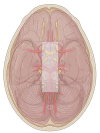Surgical Strategy for Skull Base Chordomas : Transnasal Midline Approach or Transcranial Lateral Approach
- PMID: 35286801
- PMCID: PMC9082126
- DOI: 10.3340/jkns.2021.0187
Surgical Strategy for Skull Base Chordomas : Transnasal Midline Approach or Transcranial Lateral Approach
Abstract
Objective: The clinical management paradigm of skull base chordomas is still challenging. Surgical resection plays an important role of affecting the prognosis. Endonasal endoscopic approach (EEA) has gradually become the preferred surgical approach in most cases, but traditional transcranial surgery cannot be completely replaced. This study presents a comparison of the results of the two surgical strategies and a summary of the treatment algorithms for skull base chordomas.
Methods: We retrospectively analyzed the surgical outcomes and follow-up data of 48 patients with skull base chordomas diagnosed pathologically who received transnasal midline approaches (TMA) and transcranial lateral approaches (TLA) from 2010 to 2020.
Results: Among the 48 patients, 36 cases were adopted TMA and 12 cases were performed with TLA. In terms of gross total resection (GTR) rate, 27.8% in TMA and 16.7% in TLA and with EEA alone it was increased to 38.9%, while 29.7% in primary surgery. In TMA, the cerebrospinal fluid (CSF) leak remains the most common complication (13 cases, 36.1%), other main complications included death, cranial nerve palsy, hypopituitarism, all the comparisons were no statistical significance. The Karnofsky Performance Scale scores in TMA were all better than those in TLA at different time, and the overall survival (OS) and recurrence free survival/progression free survival was just the reverse.
Conclusion: The EEA for skull base chordomas resection has improved the GTR rate, but transcranial approach is still an alternative approach. It is necessary to select an appropriate surgical approach based on the location and the pattern of tumor growth in order to obtain the best surgical outcomes.
Keywords: Chordoma, skull base; Craniotomy; Endoscopy; Surgical outcome.
Conflict of interest statement
No potential conflict of interest relevant to this article was reported.
Figures






References
-
- al-Mefty O, Borba LA. Skull base chordomas: a management challenge. J Neurosurg. 1997;86:182–189. - PubMed
-
- Chibbaro S, Cornelius JF, Froelich S, Tigan L, Kehrli P, Debry C, et al. Endoscopic endonasal approach in the management of skull base chordomas--clinical experience on a large series, technique, outcome, and pitfalls. Neurosurg Rev. 2014;37:217–224. discussion 224-225. - PubMed
-
- Choi D, Melcher R, Harms J, Crockard A. Outcome of 132 operations in 97 patients with chordomas of the craniocervical junction and upper cervical spine. Neurosurgery. 2010;66:59–65. discussion 65. - PubMed
-
- Colli B, Al-Mefty O. Chordomas of the craniocervical junction: follow-up review and prognostic factors. J Neurosurg. 2001;95:933–943. - PubMed
-
- Colli BO, Al-Mefty O. Chordomas of the skull base: follow-up review and prognostic factors. Neurosurg Focus. 2001;10:E1. - PubMed
LinkOut - more resources
Full Text Sources

